-

人教版高中英语必修5The United Kingdom说课稿4篇
Teaching Aims:Knowledge 1. Get the students to learn the useful new words and expressions in this section. Aims:2. Let the students learn about how the UK was formed and the four groups of invaders.1. Develop students’ reading ability and let them learn different Ability reading skills. Aims:2. Enable students to learn to talk about the United Kingdom and the Union Jack Emotional 1. Let students know more about the UK2. Develop students’ sense of cooperative learning Aims:Teaching Important Points:1. Let the students learn about the countries of the United Kingdom and the Union Jack2. Get the students to read the passage and know about how the UK was formed and the four groups of invaders.3. Have the students learn different reading skills.Teaching Difficult Ponts:1. Develop students’ reading ability.2. Enable students to talk about the United Kingdom and the Union Jack.3. Let students learn how the UK was formed geographically and historically.Teaching Methods:Showing pictures, asking, exercising, listening, reading etc.Teaching Aids:A computer,a projector and a blackboard.Teaching Procedures: 1) Show a map of the world, ask students the following questions:Where is the UK?What’s the full name of the UK?2) Ask the students work in pairs to do the quiz on Page 9.Do you want to test how many things you know about the United Kingdom? Let’s have a small test.Using the map on P9, students answer the following questions:?How many countries does the UK consist of? What are they??England is divided into three main areas. Do you know what they are? 1) Scanning (10Minutes )Let the students hold the questions asked in pre-reading and read the passagequickly and then let them do the following exercise.Join lines to the right answer.

人教版高中地理必修2绿色产品知多少说课稿
各小组派代表汇报。4、教师提出问题组织学生讨论:⑴要想了解更多的绿色食品,了解绿色食品的销售情况,我们应该怎么做?⑵要想了解广大消费者对绿色食品的态度,食用绿色食品的意义,是否懂得辨认绿色食品,以及什么样的人群对此知识最缺乏等,我们应该怎么做?组织学生汇报交流。5、做个“绿色食品”广告设计师。为你喜欢的绿色食品设计广告语,每组推荐一个。6、让学生了解绿色食品认证程序。7、绿色食品打“假”队员在行动。8、向学生介绍生态绿色食品基地。三、活动总结:通过研究、探讨,了解学生对绿色食品的态度。提问:民以食为天,吃,是一个大问题,如果你的爸爸妈妈让你到超市买牛奶、方便面等,你会选择什么样的食品?为什么?希望通过今天的学习,同学们能够做到绿色消费,也希望你们向自己的家人、向周围的了解学生对“无公害食品”、“有机食品”与“绿色食品”的认识。
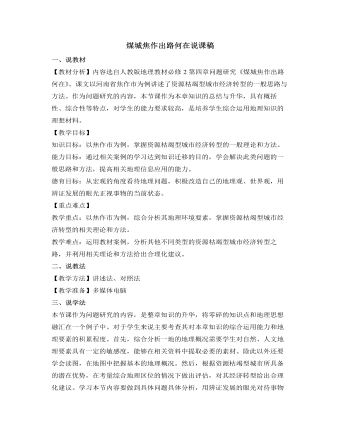
人教版高中地理必修2煤城焦作出路何在说课稿
分析过焦作市的地理概况和产业优势后,就需要针对由于资源枯竭所带来的问题提出合理化的建议。既然是谈经济转型,就应该将话题的范围明确在这一领域内。通过材料3的相关内容,我们了解到焦作市需要在产业结构调整、培育新的优势产业、增强综合竞争力等三个整改方针上下功夫。因而引导学生针对优势与不足提出建议,以三个整改方针为基准,衡量建议的可行性是锻炼学生解决此类问题的有效途径。在此我将教会学生的是解决问题方法而非案例的内容,正所谓“授之以鱼,不如授之以渔”。接下来针对学生的建议和教材资料分析所罗列的10点整改思路,由学生自由发言提出看法,通过教师的指导和学生的讨论,进而确定经济转型建议的具体方案。最后注意将建议与产业优势相对照,看建议是否都是围绕着产业优势而提出的,这样做会加深学生的印象,通过建议和优势的对应关系,将不难找出此类问题的解题思路。

幼儿园中班音乐活动说课稿 小雨沙沙沙
1 导入歌曲2 熟悉旋律“请小朋友闭上眼睛听歌曲,边听边想,从这首歌曲中,你听到了什么?想到了什么?感受到了什么?”“听了这首歌,你有什么感觉?”请小朋友仔细听,仔细感受,把你听到的节奏用手拍出来。请小朋友用手拍腿,随音乐旋律拍出节奏来。3 熟悉歌词老师清唱歌曲,幼儿听后讲述歌曲的内容请小朋友认真听老师唱一次,听听歌曲里唱了些什么?看动画,记忆歌词(请小朋友看《小雨沙沙沙》的动画片,请你仔细的听歌词)春雨发出什么样的声音?——沙沙沙小雨在哪里?————花园里(鱼池里,田野里)花儿快乐得怎么样?——-张嘴巴(摇尾巴,向上爬)看图谱师:最开始是小雨落在花园里,花儿乐得张嘴巴然后是小雨落在鱼池里,鱼儿乐得摇尾巴。最后是是小雨落在田野里,苗儿乐得向上爬。出示图谱,按歌曲图谱练唱歌词,(放伴奏录音)老师示范,幼儿唱。“请小朋友看图谱,一起来唱这首歌。”4 幼儿练唱歌曲播放动画,集体演唱。随录音演唱请小朋友一边唱,一边用你喜欢的动作来表演
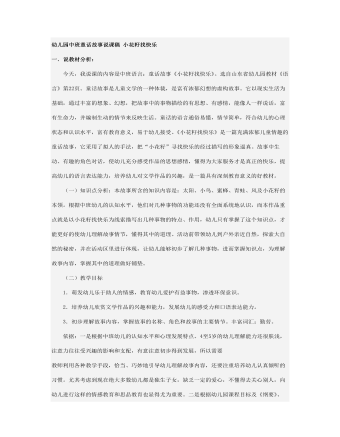
幼儿园中班童话故事说课稿 小花籽找快乐
今天,我说课的内容是中班语言:童话故事《小花籽找快乐》。选自山东省幼儿园教材《语言》第22页。童话故事是儿童文学的一种体裁,是富有浓郁幻想的虚构故事。它以现实生活为基础,通过丰富的想象、幻想,把故事中的事物描绘的有思想、有感情,能像人一样说话,富有生命力,并编制生动的情节来反映生活。童话的语言通俗易懂,情节简单,符合幼儿的心理状态和认识水平,富有教育意义,易于幼儿接受。《小花籽找快乐》是一篇充满浓郁儿童情趣的童话故事,它采用了拟人的手法,把“小花籽”寻找快乐的经过描写的形象逼真。故事中生动、有趣的角色对话,使幼儿充分感受作品的思想感情,懂得为大家服务才是真正的快乐,提高幼儿的语言表达能力,培养幼儿对文学作品的兴趣,是一篇具有深刻教育意义的好教材。
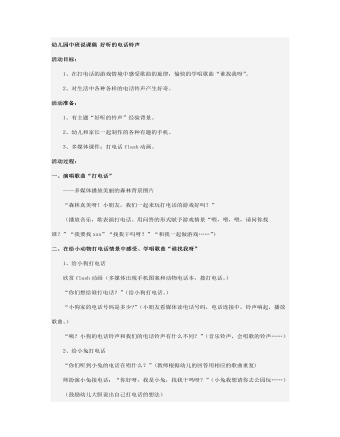
幼儿园中班说课稿 好听的电话铃声
1、给小狗打电话 欣赏flash动画(多媒体出现手机图案和动物电话本,拨打电话。) “你们想给谁打电话?”(给小狗打电话。) “小狗家的电话号码是多少?”(小朋友看媒体读电话号码,电话连接中,铃声响起,播放歌曲。) “咦?小狗的电话铃声和我们的电话铃声有什么不同?”(音乐铃声,会唱歌的铃声……) 2、给小兔打电话 “你们听到小兔的电话在唱什么?”(教师根据幼儿的回答用相应的歌曲重复) 师扮演小兔接电话:“你好呀,我是小兔,找我干吗呀?”(小兔我想请你去公园玩……) (鼓励幼儿大胆说出自己打电话的想法) 3、给小鸭打电话 “刚才你们打给了自己的好朋友,我也想打给我的动物朋友,猜猜我的电话打给谁?”(把谜语作为歌词演唱歌曲) “我有圆脑袋,穿着黄黄衣,走路摇摇摆,猜猜我是谁?” “唱歌呷呷呷,爱吃鱼和虾,我是小鸭子,你们猜对了!” (师生共同拨打电话。教师范唱歌曲《谁找我》) “小鸭子在忙什么?怎么还不接电话呢?”(在河里游泳。)(幼儿再唱歌曲) 4、给大象打电话 说说大象的电话铃声和小兔的铃声有什么不同?(辨别声音粗细快慢的不同)学唱大象的歌曲铃声。
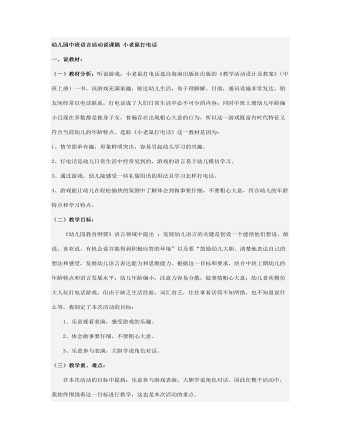
幼儿园中班语言活动说课稿 小老鼠打电话
听说游戏:小老鼠打电话选自海南出版社出版的《教学活动设计及教案》(中班上册)一书。该游戏充满童趣,贴近幼儿生活,易于理解解。目前,通讯设施非常发达,朋友间经常以电话联系,打电话成了人们日常生活中必不可少的内容;同时中班上册幼儿年龄偏小且现在多数都是独身子女,普遍存在出现粗心大意的行为,所以这一游戏既富有时代特征又符合当前幼儿的年龄特点。选取《小老鼠打电话》这一教材是因为:1、情节简单有趣,形象鲜明突出,容易引起幼儿学习的兴趣。2、打电话是幼儿日常生活中经常见到的,游戏的语言易于幼儿模仿学习。3、通过游戏,幼儿能感受一些礼貌用语的用法且学习怎样打电话。4、游戏能让幼儿在轻松愉快的氛围中了解体会到做事要仔细,不要粗心大意,符合幼儿的年龄特点和学习特点。
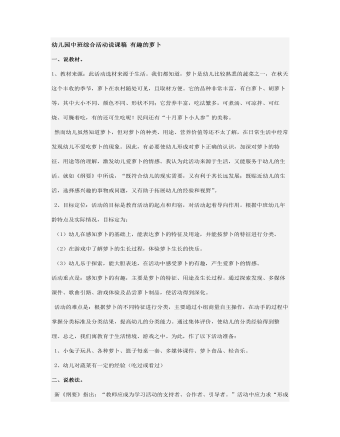
幼儿园中班综合活动说课稿 有趣的萝卜
此活动选材来源于生活。我们都知道,萝卜是幼儿比较熟悉的蔬菜之一,在秋天这个丰收的季节,萝卜在农村随处可见,且取材方便。它的品种非常丰富,有白萝卜、胡萝卜等,其中大小不同、颜色不同、形状不同;它营养丰富,吃法繁多,可煮汤、可凉拌、可红烧、可腌着吃,有的还可生吃呢!民间还有“十月萝卜小人参”的美称。 然而幼儿虽然知道萝卜,但对萝卜的种类、用途、营养价值等还不太了解,在日常生活中经常发现幼儿不爱吃萝卜的现象。因此,有必要使幼儿形成对萝卜正确的认识,加深对萝卜的特征、用途等的理解,激发幼儿爱萝卜的情感。我认为此活动来源于生活,又能服务于幼儿的生活。就如《纲要》中所说,“既符合幼儿的现实需要,又有利于其长远发展;既贴近幼儿的生活,选择感兴趣的事物或问题,又有助于拓展幼儿的经验和视野”。
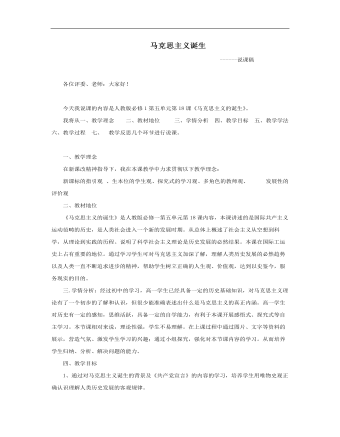
高中历史人教版必修一《马克思主义的诞生》说课稿
一、教学理念在新课改精神指导下,我在本课教学中力求贯彻以下教学理念:新课标的指引观 、生本位的学生观、探究式的学习观、多角色的教师观、 发展性的评价观二、教材地位《马克思主义的诞生》是人教版必修一第五单元第18课内容,本课讲述的是国际共产主义运动范畴的历史,是人类社会进入一个新的发展时期。从总体上概述了社会主义从空想到科学,从理论到实践的历程。说明了科学社会主义理论是历史发展的必然结果。本课在国际工运史上占有重要的地位。通过学习学生可对马克思主义加深了解,理解人类历史发展的必然趋势以及人类一直不断追求进步的精神,帮助学生树立正确的人生观、价值观,达到以史鉴今,服务现实的目的。
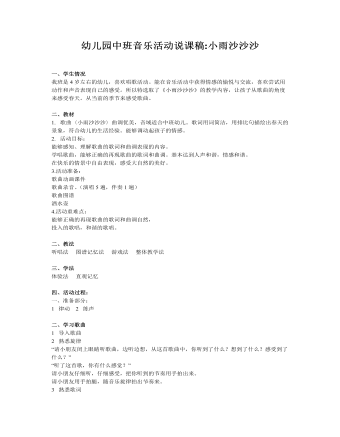
幼儿园中班音乐活动说课稿:小雨沙沙沙
二、教材 1. 歌曲〈小雨沙沙沙〉曲调优美,音域适合中班幼儿。歌词用词简洁,用排比句描绘出春天的景象,符合幼儿的生活经验。能够调动起孩子的情感。 2. 活动目标: 能够感知、理解歌曲的歌词和曲调表现的内容。 学唱歌曲,能够正确的再现歌曲的歌词和曲调。基本达到人声和谐,情感和谐。 在快乐的情景中自由表现,感受大自然的美好。 3.活动准备: 歌曲动画课件 歌曲录音。(演唱5遍,伴奏1遍) 歌曲图谱 洒水壶 4.活动重难点: 能够正确的再现歌曲的歌词和曲调自然, 投入的歌唱,和谐的歌唱。
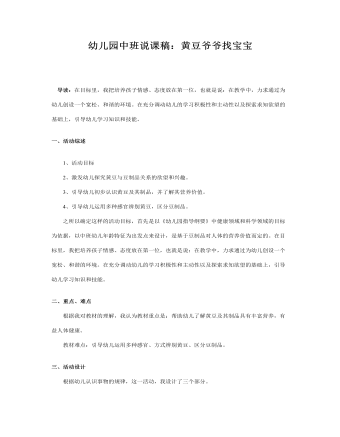
幼儿园中班说课稿:黄豆爷爷找宝宝
一、活动综述1、活动目标2、激发幼儿探究黄豆与豆制品关系的欲望和兴趣。3、引导幼儿初步认识黄豆及其制品,并了解其营养价值。4、引导幼儿运用多种感官辨别黄豆,区分豆制品。 之所以确定这样的活动目标,首先是以《幼儿园指导纲要》中健康领域和科学领域的目标为依据,以中班幼儿年龄特征为出发点来设计,是基于豆制品对人体的营养价值而定的。在目标里,我把培养孩子情感、态度放在第一位,也就是说:在教学中,力求通过为幼儿创设一个宽松、和谐的环境。在充分调动幼儿的学习积极性和主动性以及探索求知欲望的基础上,引导幼儿学习知识和技能。二、重点、难点 根据我对教材的理解,我认为教材重点是:帮助幼儿了解黄豆及其制品具有丰富营养,有益人体健康。 教材难点:引导幼儿运用多种感官、方式辨别黄豆、区分豆制品。
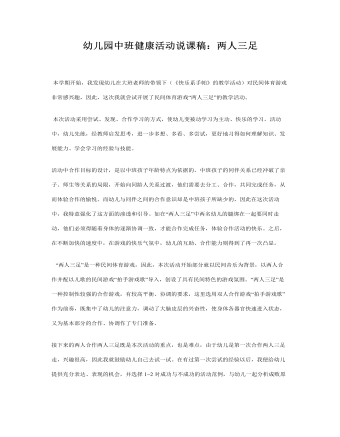
幼儿园中班健康活动说课稿:两人三足
活动中合作目标的设计,是以中班孩子年龄特点为依据的。中班孩子的同伴关系已经冲破了亲子、师生等关系的局限,开始向同龄人关系过渡,他们需要去分工、合作,共同完成任务,从而体验合作的愉悦。而幼儿与同伴之间的合作意识却是中班孩子所缺少的,因此在这次活动中,我特意强化了这方面的渗透和引导。如在“两人三足”中两名幼儿的腿绑在一起要同时走动,他们必须得随着身体的逐渐协调一致,才能合作完成任务,体验合作活动的快乐。之后,在不断加快的速度中,在游戏的快乐气氛中,幼儿的互助、合作能力则得到了再一次凸显。 “两人三足”是一种民间体育游戏,因此,本次活动开始部分就以民间音乐为背景,以两人合作并配以儿歌的民间游戏“拍手游戏歌”导入,创设了具有民间特色的游戏氛围。“两人三足”是一种控制性较强的合作游戏,有较高平衡、协调的要求,这里选用双人合作游戏“拍手游戏歌”作为前奏,既集中了幼儿的注意力,调动了大脑皮层的兴奋性,使身体各器官快速进入状态,又为基本部分的合作、协调作了专门准备。
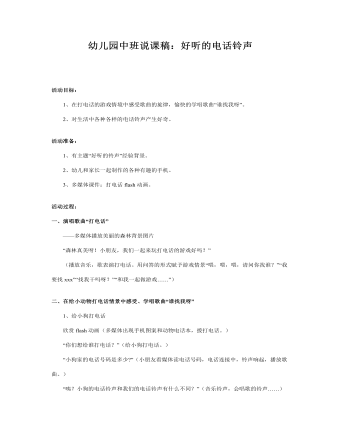
幼儿园中班说课稿:好听的电话铃声
2、对生活中各种各样的电话铃声产生好奇。活动准备:1、有主题“好听的铃声”经验背景。2、幼儿和家长一起制作的各种有趣的手机。3、多媒体课件:打电话flash动画。活动过程:一、演唱歌曲“打电话”——多媒体播放美丽的森林背景图片“森林真美呀!小朋友,我们一起来玩打电话的游戏好吗?” (播放音乐,歌表演打电话。用问答的形式赋予游戏情景“喂,喂,喂,请问你找谁?”“我要找xxx”“找我干吗呀?”“和我一起做游戏……”)二、在给小动物打电话情景中感受、学唱歌曲“谁找我呀”1、给小狗打电话 欣赏flash动画(多媒体出现手机图案和动物电话本,拨打电话。)“你们想给谁打电话?”(给小狗打电话。)“小狗家的电话号码是多少?”(小朋友看媒体读电话号码,电话连接中,铃声响起,播放歌曲。)“咦?小狗的电话铃声和我们的电话铃声有什么不同?”(音乐铃声,会唱歌的铃声……)2、给小兔打电话“你们听到小兔的电话在唱什么?”(教师根据幼儿的回答用相应的歌曲重复) 师扮演小兔接电话:“你好呀,我是小兔,找我干吗呀?”(小兔我想请你去公园玩……) (鼓励幼儿大胆说出自己打电话的想法)3、给小鸭打电话“刚才你们打给了自己的好朋友,我也想打给我的动物朋友,猜猜我的电话打给谁?”(把谜语作为歌词演唱歌曲)“我有圆脑袋,穿着黄黄衣,走路摇摇摆,猜猜我是谁?”“唱歌呷呷呷,爱吃鱼和虾,我是小鸭子,你们猜对了!” (师生共同拨打电话。教师范唱歌曲《谁找我》)“小鸭子在忙什么?怎么还不接电话呢?”(在河里游泳。)(幼儿再唱歌曲)4、给大象打电话 说说大象的电话铃声和小兔的铃声有什么不同?(辨别声音粗细快慢的不同)学唱大象的歌曲铃声。三、变出歌曲铃声“小动物们的电话铃声会唱歌,真好听,我们也来给自己的电话设计一个音乐铃声?”(师演唱一首幼儿学过的歌曲,作为自己的手机铃声,启发幼儿运用学过的歌曲为自己的手机设计铃声。)1、戴上自己制作的手机。2、“让我们的电话也会唱歌。”说说、唱唱幼儿自己设计的歌曲铃声。(复习熟悉的歌曲)
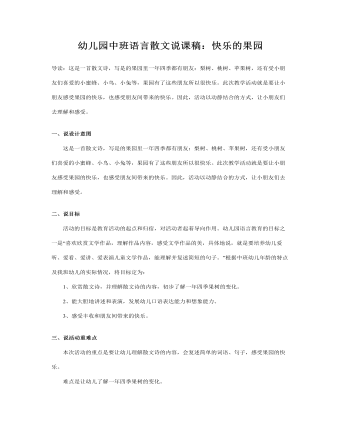
幼儿园中班语言说课稿:快乐的果园
一、说设计意图 这是一首散文诗,写是的果园里一年四季都有朋友:梨树、桃树、苹果树,还有受小朋友们喜爱的小蜜蜂、小鸟、小兔等,果园有了这些朋友所以很快乐。此次教学活动就是要让小朋友感受果园的快乐,也感受朋友间带来的快乐。因此,活动以动静结合的方式,让小朋友们去理解和感受。二、说目标 活动的目标是教育活动的起点和归宿,对活动者起着导向作用。幼儿园语言教育的目标之一是“喜欢欣赏文学作品,理解作品内容,感受文学作品的美,具体地说,就是要培养幼儿爱听、爱看、爱讲、爱表演儿童文学作品,能理解并复述简短的句子。”根据中班幼儿年龄的特点及我班幼儿的实际情况,将目标定为:1、欣赏散文诗,并理解散文诗的内容,初步了解一年四季果树的变化。2、能大胆地讲述和表演,发展幼儿口语表达能力和想象能力。3、感受丰收和朋友间带来的快乐。
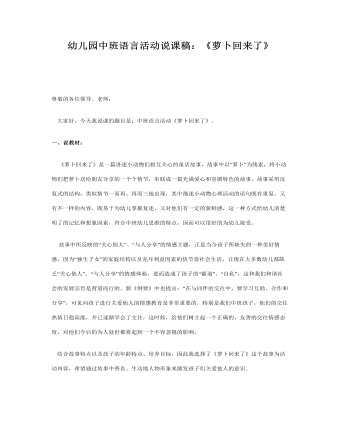
幼儿园中班语言活动说课稿:萝卜回来了
一、说教材: 《萝卜回来了》是一篇讲述小动物们相互关心的童话故事,故事中以“萝卜”为线索,将小动物们把萝卜送给朋友分享的一个个情节,串联成一篇充满爱心和喜剧特色的故事。故事采用反复式的结构,类似情节一而再、再而三地出现,其中描述小动物心理活动的语句既有重复,又有不一样的内容,既易于为幼儿掌握复述,又对他们有一定的新鲜感,这一种方式给幼儿清楚明了的记忆和想象因素,符合中班幼儿思维的特点,因而可以很好的为幼儿接受。 故事中所反映的“关心他人”、“与人分享”的情感主题,正是当今孩子所缺失的一种美好情感,因为“独生子女”的家庭结构以及充斥利益因素的快节奏社会生活,让现在大多数幼儿都缺乏“关心他人”、“与人分享”的情感体验,进而造成了孩子的“霸道”、“自私”,这和我们和谐社会的发展宗旨是背道而行的。新《纲要》中也提出:“在与同伴的交往中,要学习互助、合作和分享”,可见向孩子进行关爱他人的情感教育是非常重要的。特别是我们中班孩子,他们的交往热情日趋高涨,并已逐渐学会了交往,这时候,给他们树立起一个正确的、友善的交往情感态度,对他们今后的为人处世都将起到一个不容忽视的影响。 结合故事特点以及孩子的年龄特点、培养目标,因此我选择了《萝卜回来了》这个故事为活动内容,希望通过故事中善良、生动地人物形象来激发孩子们关爱他人的意识。
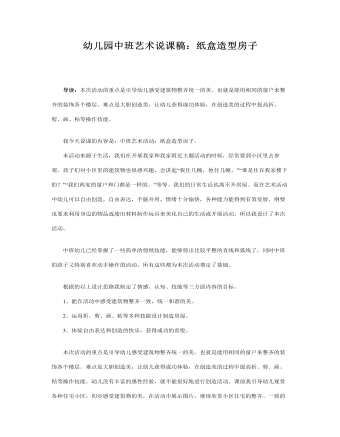
幼儿园中班艺术说课稿:纸盒造型房子
我今天说课的内容是:中班艺术活动:纸盒造型房子。 本活动来源于生活,我们在开展我家和我家附近主题活动的时候,经常要到小区里去参观。孩子们对小区里的建筑物也很感兴趣,会讲起“我住几幢,他住几幢。”“谁是住在我家楼下的?”“我们两家的窗户和门都是一样的。”等等。我们的日常生活也离不开房屋。而在艺术活动中幼儿可以自由创造,自由表达,手脑并用,情绪十分愉快,各种能力能得到有效发展。纲要也要求利用身边的物品或废旧材料制作玩具来美化自己的生活或开展活动。所以我设计了本次活动。 中班幼儿已经掌握了一些简单的剪纸技能,能够剪出比较平整的直线和弧线了,同时中班的孩子又特别喜欢动手操作的活动,所有这些都为本次活动奠定了基础。 根据的以上设计思路我制定了情感、认知、技能等三方面内容的目标。1、能在活动中感受建筑物整齐一致,统一和谐的美。2、运用折、剪、画、粘等多种技能设计制造房屋。3、体验自由表达和创造的快乐,获得成功的喜悦。 本次活动的重点是引导幼儿感受建筑物整齐统一的美。也就是能用相同的窗户来整齐的装饰各个楼层。难点是大胆创造美,让幼儿获得成功体验,在创造美的过程中提高折、剪、画、粘等操作技能。幼儿没有丰富的感性经验,就不能很好地进行创造活动。课前我引导幼儿观赏各种住宅小区,初步感受建筑物的美,在活动中展示图片,继续欣赏小区住宅的整齐、一致的美,从而激发幼儿创造美的强烈愿望。在技能方面使用双面胶粘东西较难,用过的次数不是很多,要重点指导。我为幼儿提供了丰富的操作材料,让幼儿自由设计,自由创造,并引导幼儿获得成功。 本次活动我准备了各种建筑物图片、窗户图形片、各类盒子、瓶子、幼儿用的彩笔、剪刀、胶水、双面胶、彩色纸等大量操作材料。

人教版高中语文必修1《纪念刘和珍君》说课稿3篇
1.说教材《记念刘和珍君》是鲁迅先生用饱醮着热泪,用悲愤的笔调写下的一篇感人至深的散文,既有对爱国青年沉痛的悼念,又有对反动派愤怒的控诉,也有对觉醒的国民的呐喊。《记念刘和珍君》是高中语文必修1第三单元第一课的讲读课文。文中描摹人物的音容笑貌,叙述人物的行为事迹,都融入了作者真挚的情感和深刻的感悟。对学生明辨是非,领悟时代精神和人生意义,有着重要的作用。新课标强调了要全面提升高中学生的语文素养,初步形成正确的世界观、人生观、价值观,并学会收集、判断、处理信息,具有人文素养、创新精神与实践能力。同时,《记念刘和珍君》感情真挚,感悟深刻,具有典型人文性。结合本单元教学目标,确立教学目标如下。
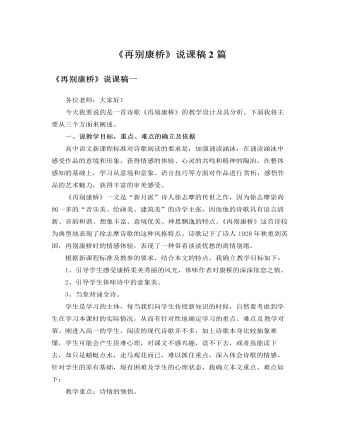
人教版高中语文必修1《再别康桥》说课稿2篇
一、教材分析1、教学对象分析《再别康桥》的教学对象是高一学生,高一学生往往对那种纯粹的、原始的、本真的情感体会较为肤浅,《再别康桥》是新月派诗人徐志摩的传世之作,有极高美学价值,它所抒发的离愁别绪是人类共同的情感经历,通过诵读容易将学生带人诗境,唤醒他们沉寂的真情,从而引起强烈的共鸣。 2、教材地位及作用 高中语文第一册第一单元为诗歌单元,本单元收录了中国现当代的一些优秀诗篇。《再别康桥》安排在本单元的第二课,属于必读课。虽然本诗向来众说纷纭,但其艺术之美人所共知,培养学生高尚的审美情趣和良好的审美创造力是语文学科的任务,因此,从语言赏析入手,从情感体验切入,就可以让学生通过学习本课体会现代诗歌的特点,多方面感受体悟诗歌的情感,受到美的熏陶。
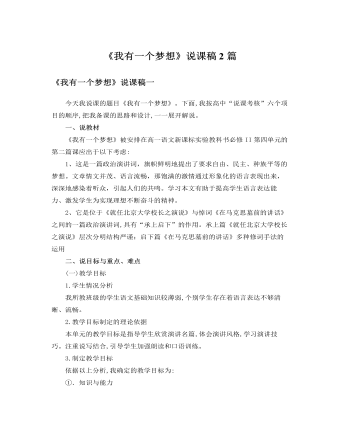
人教版高中语文必修2《我有一个梦想》说课稿2篇
(2).教学手段为了使我根据教材而设计的三个教学目标以及重点难点得以的突出和突破,达到最大化的展示境界,同时也为了配合以上我选择的四种教法得以完满实现,我决定采用“多媒体”教学手段进行全程教学。利用电脑的信息容量大,操作简便等优点,形象生动的直观展示教学内容,不但提高学习效率和质量,而且容易激发学生的学习兴趣和调动学习的积极性。四、说学法我为学生设计了三个学习方法:1.让学生学会在探究中学。通过“对黑人严酷处境的探究”和对文中重点语句的探究,培养学生在探究中学习的能力。2.让学生学会在读中学。通过“诵读法”指导学生在诵读过程中感受演讲词内在的魅力,学会在读中学。3.让学生学会在练习中学。通过“课外延伸练习法”,对所学的知识进行运用,培养学生的创新和自学能力。
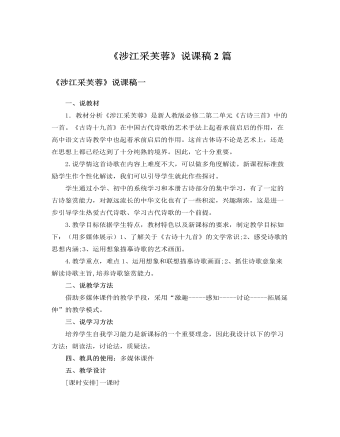
人教版高中语文必修2《涉江采芙蓉》说课稿2篇
一、说教材1.教材分析《涉江采芙蓉》是新人教版必修二第二单元《古诗三首》中的一首。《古诗十九首》在中国古代诗歌的艺术手法上起着承前启后的作用,在高中语文古诗教学中也起着承前启后的作用。这首古体诗不论是艺术上,还是在思想上都已经达到了十分纯熟的境界。因此,它十分重要。2.说学情这首诗歌在内容上难度不大,可以做多角度解读。新课程标准鼓励学生作个性化解读,我们可以引导学生就此作些探讨。学生通过小学、初中的系统学习和本册古诗部分的集中学习,有了一定的古诗鉴赏能力,对源远流长的中华文化也有了一些积淀,兴趣渐浓,这是进一步引导学生热爱古代诗歌、学习古代诗歌的一个前提。3.教学目标依据学生特点,教材特色以及新课标的要求,制定教学目标如下:(用多媒体展示)1、了解关于《古诗十九首》的文学常识;2、感受诗歌的思想内涵;3、运用想象描摹诗歌的艺术画面。

